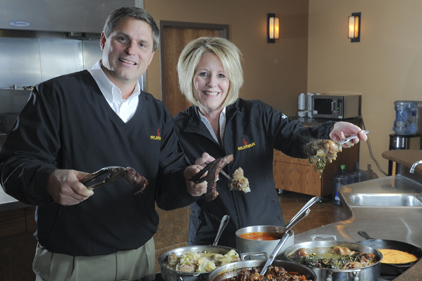When it comes to serving the needs of the multicultural meat consumer, Cargill Meat Solutions stands as the latest pioneer in an under-served segment of the meat case. Rumba is the first brand of its kind in its segment, providing fresh beef and pork variety cuts to African-American, Asian-American and Hispanic-American shoppers across the country.
Follow the trail
Today, one out of three consumers in the United States is multicultural — Hispanic- American, African-American or Asian-American — and the U.S. Census Bureau projects that by the year 2050, nearly half of the population will be multicultural (according to U.S. Census Bureau Projections, June 2007). Furthermore, these three groups are growing 2.9 times faster than the total U.S. population.
Buying-power estimates within these population segments are very strong, with Hispanic-Americans expected to have $1.4 trillion in buying power by the year 2013, African-Americans $1.2 trillion, and Asian-Americans $752 billion (according to The Multicultural Economy, Selig Center for Economic Growth, Terry College of Business, 2009).
For Cargill, these prognostications — combined with the company’s own market research on the meat case — demonstrated a real opportunity to step in, innovate and take command of the market. Tammy W. Shaw, vice president of Beef North America Sales and Marketing, Cargill Meat Solutions, says that convergence of data gave Cargill the background it needed to commit to creating the Rumba brand, which launched its first beef items in 2007.
“Our consumer research told us that there was an opportunity there, in this space in the meat case that, in the past, had been filled with products that were frozen and sometimes difficult to deal with in the back room,” she explains. “Here was an opportunity to offer these products fresh and in a package that is clear, so that consumers can see the product and know what they’re purchasing.”
Within two years, Rumba’s beef products became the category leader and experienced so much success that Cargill made the decision to extend the brand into pork. In fact, Rumba has logged double-digit year-over-year growth since the program was launched in June 2007, according to the company. Carl Hermreck, vice president of Pork Sales and Marketing, Cargill Meat Solutions, believes in the possibilities for the brand’s continued growth.
“This is not just a variety meats program — beef has expanded into muscle cuts, and we’re going to do the same thing in pork,” he says. “The brand has a lot of power and strength, and I think you can expand the product line to more muscle cuts.”
Indeed, Cargill believes Rumba has the potential to generate more than $100 million in annual sales over the next five years. Much of that strength and potential builds off the research, explains Shaw, but Rumba draws further inspiration from one group that has been involved from Day One.
“Within our own company, in our own facilities, we have a very ethnically diverse group of employees,” she says. “We realize what a huge resource our employees are, and we have asked them, to tell us what we needed to do.”
Expansion exploration
As the brand looks for ways to expand, it will continue to tap into the bevy of research and its own employees’ knowledge, says Meredith McGowan, Rumba brand manager.
“In developing the brand, we took products into the multicultural consumer’s home and we asked them to prepare the product in front of us and give us feedback,” she adds. “So through interviews with them in their homes, we learned about other products they consumed and prepared also.”
One of the solutions Rumba is able to bring to consumers comes in the form of its newest product, its time-saving tripe. McGowan states that typically tripe would take four hours to cook, but Rumba’s time-saving tripe cooks in less than one-and-a-half hours, without any additional
ingredients.
“Consumers today are more crunched for time than ever before,” she says. “This innovative product allows multicultural consumers the chance to prepare their families’ favorite traditional dishes much more quickly.”
Another step Rumba took toward putting its research into action came from the inclusion of specialty muscle cuts on the beef side — those that target the multicultural markets Rumba serves.
Beef features such cuts as hanger steak, inside skirt and outside skirt, among others, and pork will soon follow into the segment, says Donna Lin Niles, Rumba pork brand manager.
“We’ve been growing very quickly just in terms of variety cuts,” she explains. “But we see our progression going the same way beef has grown beyond variety meats and into specialty meats and muscle cuts, and convenience products.”
Winning over retailers
Convenience stands as one very important aspect for the entire line, from its packaging and extended shelf-life to its overall ease-of-use for the consumer. The total package Rumba offers has taken it to more than 5,000 locations from coast to coast, and is something Lin Niles says really hits the mark for their retail partners.
“We often hear retailers describe it as a program, which is not what they get from their frozen bulk offering,” she adds. “So the retailers know that when they’re buying the package, they’re getting a lot more than just meat or case-ready meat. They’re getting all the services that we provide to them.”
Rumba enters the partnership with each retailer stocked with strong demographic data on that retailer’s neighborhood, and backed by products that are attractive in their presentation, shelf-life capabilities and convenience.
McGowan relays that according to Rumba’s research, 8 of 10 multicultural customers shop at a mainstream retailer, but only about half of them buy their meat at that mainstream retailer.
“Whereas the multicultural consumer would have normally gone to an ethnic grocer, such as a carnicería to buy their meat, we provide the mainstream retailer a product that the multicultural consumer will pick up from their meat case,” she says. Those benefits, however, make the most sense for a mainstream retailer, Rumba’s primary target, explains Lin Niles.
“That’s where the brand benefits kick in,” she says. “If a consumer is shopping at a mainstream retailer, they’re going to see the quality, the packaging, the freshness of Rumba, whereas a carnicería or Asian market merchandises differently.”
Cargill Meat Solutions took a courageous leap into this variety-meats vacancy several years ago, planting its flag first in this territory of the market. Thus far, Rumba has been able to reward the company by improving the product offerings, using Cargill’s market research and demographically targeted merchandising.
Pioneers such as Rumba always have the courage to strike first — it’s the very essence of being a pioneer. However, if the pioneer doesn’t have the proper insight or is unable to innovate, competitors eventually erase the pioneer’s lead.
With the strength of Cargill Meat Solutions’ research and experience behind it, Rumba appears poised to maintain its position as the leading provider of fresh variety meats to the multicultural population.
| Pinpoint Targets |
|
During his visit to Cargill Meat Solutions’ Wichita, Kan., offices, Andy Hanacek, editor-in-chief of The National Provisioner, sat down with Meredith McGowan, Rumba brand manager, and Donna Lin Niles, Rumba pork brand manager, to discuss the intricacies of Rumba’s targeted multicultural demographics and how the brand uses that information to innovate and improve its offerings. What follows is a portion of the interview: Hanacek: Does Rumba’s data point to any gravitation of the brand’s consumers toward any specific products or cuts? For example, do your African-American consumers prefer a particular cut that the Asian-American demographic does not? McGowan: A lot of the products will overlap into all three consumers groups we target, but when the consumers prepare the dishes, the recipes are what make the products their own, specific to their culture. Lin Niles: Tripe, for example, is an interesting product because it appeals to multiple groups in some way, but the recipe or application is completely different. So with Vietnamese consumers in the Asian-American segment, they have a rice noodle soup named “pho,” in which the tripe is thin-sliced and eaten as part of the pho. It’s not part of the broth. But with Hispanic consumers, menudo uses pork feet as well as tripe, but the tripe is sliced into squares and is a big part of the soup — it’s actually the star of the soup. McGowan: So, as far as certain consumer groups consuming more of any item, tripe is a good example. Hispanics really love tripe, and Argentinian consumers will buy a lot of the sweetbreads; Asian consumers buy a lot of the pork products; and for African-Americans, oxtail is a good seller. Lin Niles: Also with the pork items, a lot of these applications are not for stewing or eating them as the center-of-the-plate item, but they’re flavorings. So you’ll see them added to greens or stews to add that certain flavor that you can’t get from anything else. Hanacek: Are there any other product trends on the pork side that show up in Rumba’s data? Lin Niles: Again, it depends on the group. Asian-Americans really love cuts like the feet or the ears. Those have certain cooking applications. The ears are kind of like a braised barbecue pork ear, and they’re sliced very thin. The ear has the skin on top and the bottom, and the center is kind of crunchy. The feet, you’ll see that there are several applications, but they can be braised as well and eaten just off the bone that way. With African-Americans, the tendency is toward hocks, jowls and fatbacks, and those are often used as flavorings or stews. You’ll see them with collard greens or cooked into a stew. Sometimes feet are cooked with greens as well. With the Hispanic segment, it really varies by consumer group, but I would say fried pork fatback skins — the chicharrones — are popular. But you also see neck bones cooked into stews and served over rice, or some consumers may turn them into tacos, because they’re meaty. Hanacek: So based on the demographic data you have, you’re able to tailor the product mix to each individual store based on those trends that you see, right? McGowan: We are able to tailor that product mix toward the demographic data we have, and that’s part of the overall solution that we offer the retailer. |





